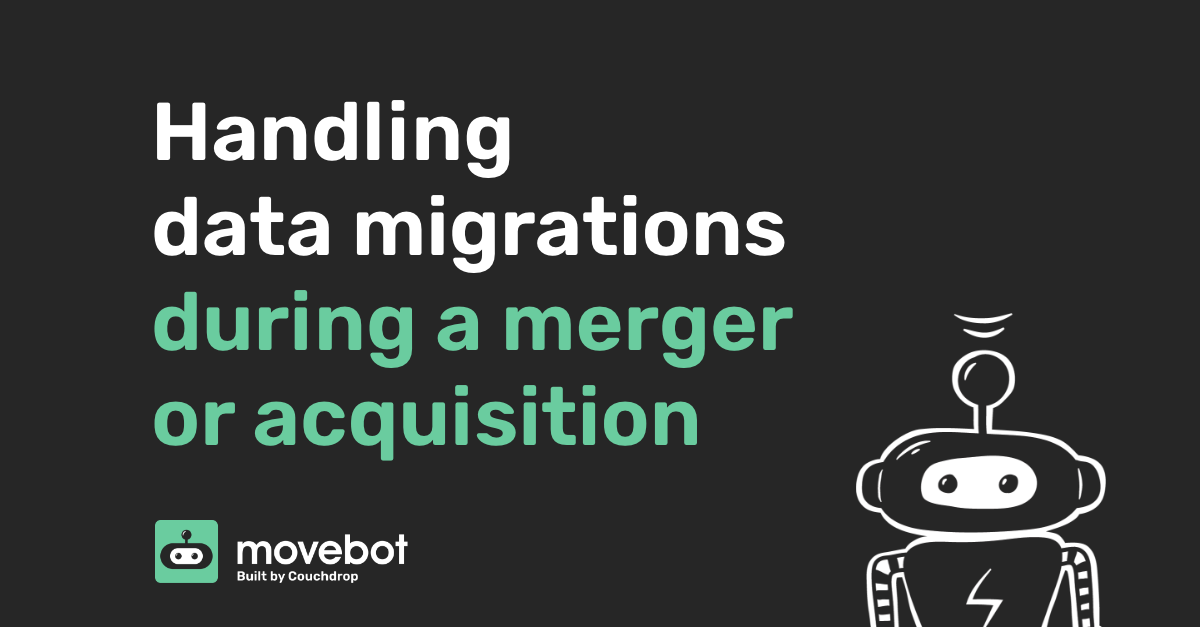
Typically, during a merger or acquisition, the new company will retain the best elements of each individual company. But what about when it comes to files? Most of the time, an acquisition or merger involves doing a large-scale data migration from one system to another. It might be cloud to cloud or from a server to the cloud.
The migration should be fast to mitigate the change in structure and management, and simple to reduce stress for everyone. Having access to required data is crucial for making updates after the merger, so the sooner the systems are integrated, the better the results.
In order to make an acquisition or merger less stressful for everyone, it’s essential to follow best practices for all three phases of the data migration process: planning the data migration, working during the data transfer, and evaluation and maintenance.
Planning the data migration
Trying to do a data migration without planning is like trying to move in with the neighbors down the road without telling them or making sure they have space for you. Even if they invited you–like in an acquisition–you might not be able to bring everything, and you’ll need to fit in with their lifestyle.
Ideally, planning out the data migration should begin before the agreement is finalized. Then, once the merger or acquisition is complete, the two separate companies can become streamlined and have access to the tools and data they need to start on improvements and upgrades.
The earlier teams can plan for a data migration, the easier it tends to be. To make the transition as smooth as possible, it’s important to create a data migration team, evaluate existing file storage, plan the migration and detail, and research and choose a data migration tool.
Create a data migration team
Someone needs to be in charge of the migration, and it’s helpful to have a team of people if you can. If possible, this team should have members from both companies who understand how files and company data are currently being managed.
The data migration team should have a full view of data from both organizations so they can have an accurate view of the data, see how it’s organized, and plan how it will be structured after the merger or acquisition is complete. By having knowledgeable people familiar with the systems in place working together, the team can decide which systems and methods to keep and which to replace.
Evaluate existing file storage
Each team will have a different way of storing and naming files. They may be using different cloud storage platforms as well. Eventually, these data groups will need to be consolidated into a single platform, and it’s up to the data migration team to decide which one will serve the merged company best. Even if both companies use the same platform like Google Workspace, there will still be challenges with the migration to consider.
Along with deciding on a platform, the data migration team should look into deciding if they need to pull across all the data or not. It may be better if some workloads or data sets are left behind. For example, data that is irrelevant to the new company might be better to be archived (block storage like Amazon S3, Azure, Backblaze, or Wasabi are great places to archive but still keep the data in the cloud) because no one will need to access it regularly. Finding where important data is stored and keeping track of this information is helpful as well, especially if the data migration team needs approval from stakeholders before making the decision.
Plan the migration in detail
Once a decision has been made about the storage platform to use, it’s crucial to plan out the migration in detail. The more comprehensive the plan, the less likely there is to be an issue. There are many things to consider, but here are a few important questions to keep in mind:
-
Will the data be migrated all at once or in batch jobs?
-
Do existing permissions need to be preserved or will they be set again after the migration?
-
Will directory and/or file names need to be modified before the migration to avoid double ups?
-
How will you notify teams of migrations that may affect their workflows?
-
Is there an expected timeframe for the migration and is it feasible for the amount of data needing to be moved?
-
Can file names and file types be transferred without errors in the new system?
-
Are you able to do a pre-migration scan to find potential issues before doing the migration?
The more questions you can answer beforehand, the less likely they are to come up after the migration has started.
Research and choose a data migration tool
Once you know how you want to do the migration, make sure that you use a tool that suits your needs. It should be easy to use, secure, have fast transfer speeds, and meet the requirements of your migration plan. For instance, if the data migration team decides to preserve permissions, the tool needs to have the capability to migrate those permissions.
Movebot is an easy-to-use migration tool with the ability to migrate users and permissions as well as options to automatically fix illegal characters in file names, duplicate names, preserve existing modification times, and much more.
Speed in Movebot is also unmatched, with the capability to move 5-10TB per day between most platforms, meaning there’s less time spent waiting for data to transfer.
Cost is another important factor, and Movebot’s affordable data moving features are significantly lower than other options. Movebot uses simple a simple pay-as-you-go pricing model where you only pay for what you use, with no per-user pricing or other fees.
Working during the data transfer
Communication is key for employees working during a data migration. Will there be files they can’t touch for a certain amount of time or folders they need to avoid? If so, affected teams as soon as possible to let them know about possible disruptions. Depending on the tool you use, there may be significant workplace disruptions during the migration.
Movebot minimizes these disruptions, but there are still some things that workers need to consider. For example, since Movebot never has access to the contents of the data, it doesn’t delete files. New files created during the migration can be pulled over with a delta migration, but files that are deleted after they’ve been migrated won’t be affected. Doing massive restructuring like removing or renaming files and directories during a migration is a bad idea with any tool, and these changes should be done in the planning stages or afterwards if necessary.
Some migration tools like Movebot also let you view the performance in real time so you can see how much data has been transferred and if there have been any errors. Keeping track of these statuses can help make the maintenance after a migration easier to handle.
Evaluation and maintenance
Moving all the data isn’t the end of the migration when you have large amounts of data like in a merger or acquisition. There are a few best practices that can help everyone get prepared for the new business as usual. These include delta migrations, familiarizing teams of new processes, and analyzing and updating workflows.
Delta Migrations
Since mergers and acquisitions tend to deal with large amounts of data, there will most likely be files that were updated during the migration. If your migration tool supports delta migrations, it can analyze the source and destination and move only files that have been updated or added. Movebot supports delta migrations and can be configured to only do delta migrations so there’s no risk of transferring files that have already been moved.
Familiarizing teams of new processes
Once the files have been moved to the new platform, it will take employees some time to get used to the change. There might be new ways of organizing files and new steps for proofing and approval, such as moving files to different directories for different stages of a project. It’s helpful to give employees time to adapt to the new platform and to provide them with policies, procedures, and use-case scenarios they can refer back to as needed.
Analyzing and updating workflows
It can be hard to change up workflows and processes once they’ve been decided, but it’s important to be flexible and make sure that they fit the new organization. For file architecture and management, there are a few important questions to keep in mind during the early months of an acquisition or merger like:
-
Can teams find the files that they need?
-
Do the right people have access to the necessary files?
-
Do file naming conventions make sense and are they being followed?
-
Can old versions of files be accessed if needed?
-
Are there additional features on the new platform that can improve workflows?
Regular evaluations, especially in the early stages of an acquisition or merger, can help make the transition easier and better for everyone involved.
Considering moving data as part of a merger or acquisition?
After a merger or acquisition, it can take some time for employees to work fluidly in a new platform. But by planning the data migration, knowing how to work during the data transfer, and evaluating and maintaining workflows on the new platform, it can help the process go smoothly and be easier for employees.
If you need to migrate data as part of a merger or acquisition, check out Movebot. It’s easy to use with fast transfer speeds and several features to make the transition to a new platform as painless as possible. Register for a free trial or contact us to learn more or to schedule a demonstration.






